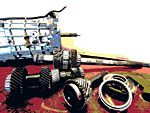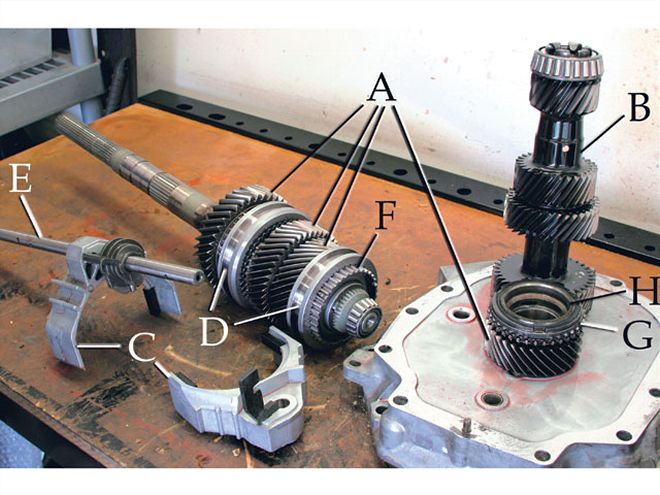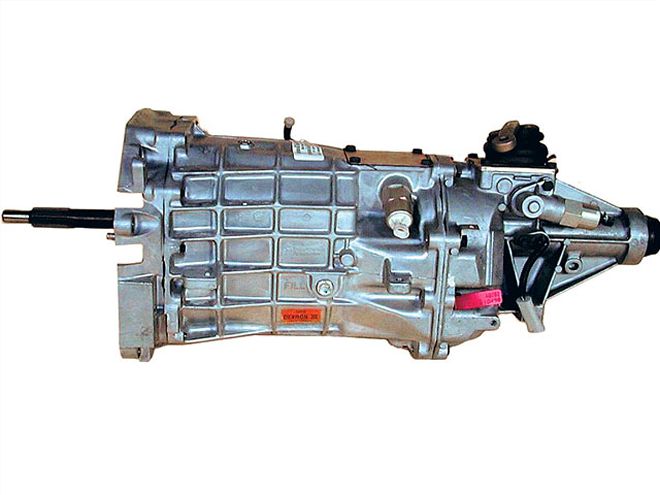
The vast majority of g-Machine enthusiasts are of the clutch-pedal-and-H-gate variety, and the most popular trans of choice is undoubtedly the Tremec T56. And why not? It's all over the salvage yards and eBay, it's extremely affordable, remarkably robust, and offers double-overdrive cogs for respectable gas mileage even with a deep ring-and-pinion set. Nevertheless, nothing's perfect, and the Camaros, Mustangs, and Vipers most T56 transmissions started life in have a propensity for being run hard. Enough weight, power, and clutch bite-as in 6,000 rpm launches on Mickey Thompsons-will do in even the mighty T56 and quickly reveal its weak links. We teamed up with T56 Rebuilds and Rockland Standard Gear to show you how to diagnose the health of your T56 and beef it up to suit your application if necessary.
Anatomy of the T56
By far, the most common source of T56 transmissions on the used market is the Fourth-Gen F-body, primarily due to its longish production run from '93-'02. Although the T56 has been used in the Dodge Viper since the early '90s (in addition to the '03-'04 Mustang Cobra, '04-and-up Pontiac GTO, and Cadillac CTS-V), much lower production numbers make them less likely swap candidates. Likewise, the C5 Corvette-with its rear transaxle layout-makes a potential conversion far less appealing. Nonetheless, other than varying rear tailshaft housings, front adapter plates, and bellhousings, the transmission cases and the internal components within them are remarkably similar in each version of the T56. Consequently, the rebuild procedures outlined in this story are universal, and parts from stronger variants of the T56 easily interchange with its more feeble brethren. All T56s feature die-cast aluminum construction, paring mass to a trim 130 pounds.
Breakage
The most common F-body box features an official torque capacity rating of 450 lb-ft, but hoards of racers have subjected them to well over that figure without much fuss. From a durability standpoint, the primary difference between the Viper trans and lesser T56s is its thicker output shaft measuring 1.290 inches versus 1.175 inches. Likewise, the Viper shaft allocates its torque load over 30 splines, as opposed to 27. As far as parts failure from sheer driveline shock is concerned, the output shaft is the first to go.
Although upgrading to a Viper output shaft is a must in hardcore drag racing applications exceeding 900 horsepower, very few street cars actually break the stock piece. In fact, non-Viper T56s can handle close to 750 hp in most street applications. On the other hand, most of the components replaced during a typical rebuild are normal wear and tear items, such as synchros and friction cones. Improperly setup clutches that don't fully disengage compound the problem. In other words, the T56 has a lot more strength than the average backyard clutch installer has common sense, and is therefore much more durable than its reputation may suggest. "Most of the problems people have with their transmission-like grinding or popping out of gear-are due to not addressing the hydraulic system when replacing a clutch," says Joe Overton of T56 Rebuilds.
Regardless of whose fault transmission wear may be, the T56 isn't perfect. Due to its small diameter in relation to the 1-2 shift fork, the factory cast aluminum 3-4 fork is a common problem area. Of course, the 5-6 fork is smaller still, but hard shifts into overdrive are rare. Rebuilds typically include an upgraded steel 3-4 fork along with rugged billet steel keyways to replace the factory aluminum pieces. Furthermore, upgraded carbon fiber synchros further improve resilience to gear banging. Synchronizer sleeves and fork pads simply wear out as opposed to breaking, so replacement with fresh stock parts will suffice. All parts are available directly through Tremec, and its distributors, such as Rockland Standard Gear.
Repair
We're all for turning your own wrenches and saving a few bucks, but rebuilding a transmission is probably best left to the professionals. Not only is there a harrowing volume of gears, bearings, pins, shafts, screws, and locks in varying sizes that all look the same, but misplacing just one of them can blow up your trans. In comparison, assembling a short-block is a walk in the park. If you're still feeling rather intrepid, a quick look through a service manual will probably change that pretty quickly. Seeking the expertise of someone much smarter than ourselves, we closely observed Joe Overton of T56 Rebuilds as he performed a basic rebuild. Here are the highlights.

HOW IT WORKS
Chances are the images presented before you tell nothing about how a manual transmission actually works. Even to an experienced wrench, the guts of a transmission are sometimes a confusing jumble of parts. Unless you know exactly what is going on inside the trans case as the shifter flips through the gates, it's almost impossible to understand which parts break and why. So here's a quick and palatable run down. All forward drive gears rotate around the axis of the output shaft under power, but that's it. They don't actually shift position when the shifter moves from gate to gate, so the terms "shifting gears" and "grinding gears" are a bit misleading. Like most modern manual transmissions, the T56 is a constant mesh design, meaning the forward drive gears (A) are constantly in contact with and driven by the gears on the counter shaft (B). In other words, although power is transmitted through just one gear at a time, gears 1-6 are constantly rotating on the output shaft. How can that be?
Each gear rides on a bearing, so when it's not selected or the car is coasting in neutral with the clutch engaged it freewheels around the output shaft. Between each pair of gears (First and Second; Third and Fourth; Fifth and Sixth) is a shift fork (C), and each fork's prongs are attached to a synchronizer sleeve (D), also called a slider. Collectively, the myriad components housed inside the slider are referred to as the synchronizer assembly. Unlike the drive gears, the sliders attach directly to the output shaft via splines and when they mate with the selected gear, power is transmitted.
As the shift lever engages a gear, it moves the shift rod (E), shift fork, and slider fore or aft. Inside the slider is the synchronizer hub (F), which is what the slider slides on when pressure is exerted on it by the shift fork. The drive gears, First through Fourth in this example, feature an elevated section (G) with straight-cut teeth, and on this elevated section rides a separate blocking ring (H), also referred to as the synchro. In the case of the T56, there are two friction cones between the synchronizer hub and blocking ring. As the synchronizer hub mates with the face of the blocking ring, the friction cones slip until the rotational speeds of the drive gear and the entire synchronizer assembly match. It is then that the slider slips over the straight-cut teeth (sometimes called "dog" teeth, (G)) on the drive gear and engages. Since the slider is attached directly to the splines of the output shaft, power is then transmitted at the ratio determined by the drive gear.

T56 Maximus
For the pragmatists among us who would rather not roll the dice with a junkyard trans, or for those looking to build a virtually indestructible T56, Rockland Standard Gear has you covered. The company distributes new replacement parts to transmission repair shops and dealers and offers new and rebuilt transmissions backed by a one-year unlimited mileage warranty. However, that's just a fraction of Rockland's operation. Head honcho Michael Weinberg drives the Powell Motorsports Corvette Z06 in the Grand Am series, has four championships under his belt, and implements the lessons learned from racing into building killer street transmissions.
Rockland offers new direct bolt-in T56 transmission kits for small-block Chevys and Fords for under $2,000. For big dogs who already have a T56, Rockland will beef it up to handle over 750 rear-wheel hp with a 30-spline output shaft, carbon fiber blocker rings, and a steel 3-4 shift fork for $2,095. One of the most significant benefits Rockland offers is blueprinting and shimming internal clearances in each of its transmissions. "If you don't get the tolerances just right, you'll shear the teeth right off the gears," says Vice President of Remanufacturing George Kreppein. "We even blueprint the new factory Tremec transmissions we sell, which makes them a lot stronger than what comes on the production cars."
Beyond the basic bundled packages, each transmission is fully customizable to meet the end user's specifications. "Our basic labor charge is $350, but from there you can do whatever you want," says George. "We can replace all the bearings, retainer clips, and keys and upgrade all the shift forks to steel if you want." Rockland even manufactures its own gears built from 9310 Nickel alloy steel, which allows tailoring ratios specifically for your setup. Engine combos with a lot of cam can swap in shorter 0.80 and 0.62 overdrive ratios compared to the typical 0.74 and 0.50 gears. Additionally, a 2.97 first gear is available as an upgrade to the common 2.66 gear. If you still want to try it yourself, Rockland offers all its parts individually.